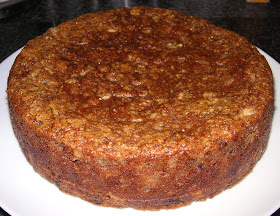
I know it sounds silly to choose what to bake on its shape, but I really fancied a traybake this week. It was partly because I wanted to use my new traybake tin with fitted lid (OK, so I was meant to be Christmas shopping but surely presents for me count?) but mostly because I wanted the delicious cuboid of cakey goodness that only a traybake can deliver. There’s something so appealing about a piece of cake that’s a tall as it is wide and deep. Unfortunately, I didn’t quite achieve it because the recipe requires a 20cm x 30cm tin and I used one that was 25cm x 37cm.
The cake part of this recipe is a rich, buttery almond sponge, lightened by the inclusion of yoghurt. For the fruit element I visited the supermarket and just chose what appealed to me. The recipe will work at any time of year with a variety of fruits. I picked raspberries and blueberries because I love them in any cake and apricots because I have never used them before in my baking.
Being blessed with a “healthy appetite” (i.e. gluttonous) I categorise most cakes as “cut and come again”, but this one truly is – it’s light and the fruit kids you that it might be healthy. It isn’t of course …particularly when each cuboid is teamed with a generous splodge of thick cream!
The colours of the fruit looked beautiful alongside each other in my shopping basket and equally as pretty in the finished cake. Winter blues? I’m more into my winter reds and oranges!

No blog post from me next weekend as Mr CC and I are off on hols (technically it’s our honeymoon but there’s just something about that word that makes my teeth itch so I’m not using it!)…I think this is the first week I’ve skipped since starting my blog in September 2007 thus I hope you won’t judge me too harshly. Normal service will resume on Sunday 12th December.
Ingredients
250g unsalted butter, at room temperature
250g golden caster sugar
4 eggs
1 teaspoon almond extract
240g self raising flour
½ teaspoon baking powder
40g ground almonds
150g Greek yoghurt
300g fruit – you can use any juicy, flavoursome fruit – I used a mix of raspberries, blueberries and apricots.
50g flaked almonds
Optional: icing sugar to dust over before serving
To serve: thick cream
Method
Preheat the oven to 180˚C/fan oven 160˚C/350˚F/Gas mark 4.
Line a 20cm x 30cm tin with baking paper.
Beat the butter until it is soft and creamy, then add the sugar and beat further until it is light and pale. Don’t skimp on this stage as this is where you get the air into your sponge.
Beat in the eggs one at a time – if it looks like it might curdle add some of the flour.
Beat in the almond extract.
Fold in the flour, baking powder and ground almonds.
Fold in the Greek yoghurt.
Gently fold in the fruit taking care to leave as much of it intact as possible.
Spoon the batter into the prepared tin and level the surface.
Scatter over the flaked almonds.
Bake for approximately 30 minutes or until a skewer inserted into the cake comes out clean. Mine took 40 minutes.
Leave to cool in the tin. It will keep, in an airtight container for several days. I often find that a cake with almonds tastes better a day or two after baking as the almond flavour intensifies and the nutty oils moisten the cake.
If desired, sift over icing sugar before serving.
Serve with a generous dollop of thick cream.
Bask in the glory of the wonderful thing you have created.



















.JPG)


